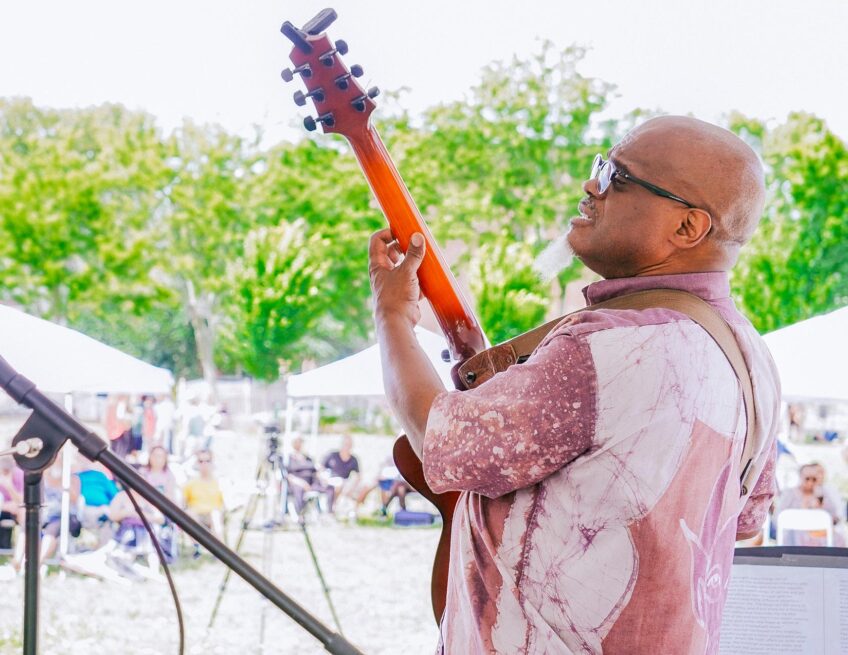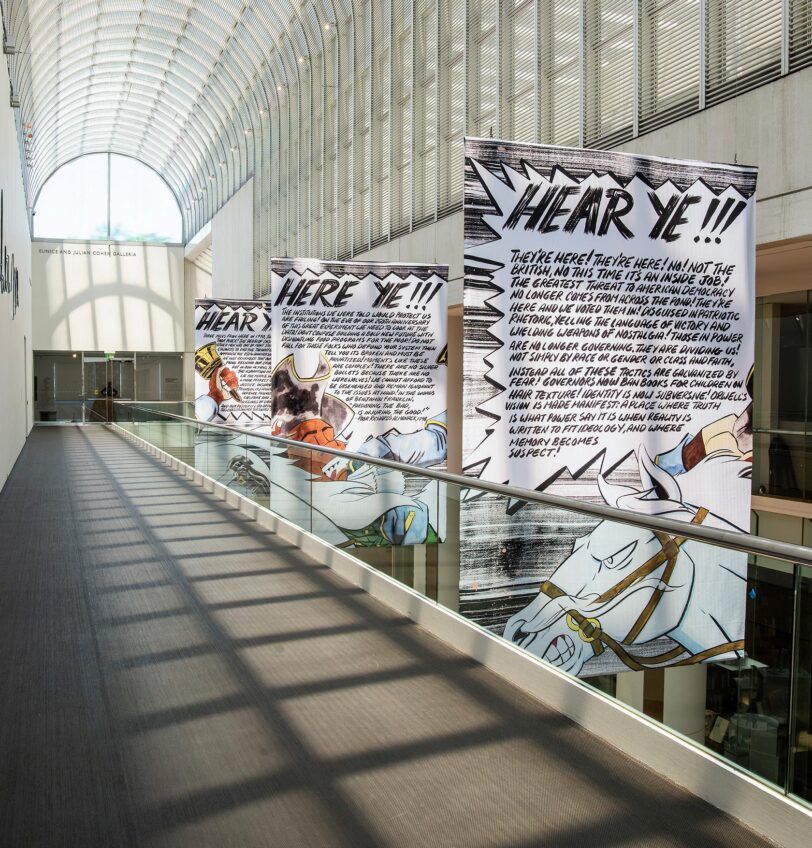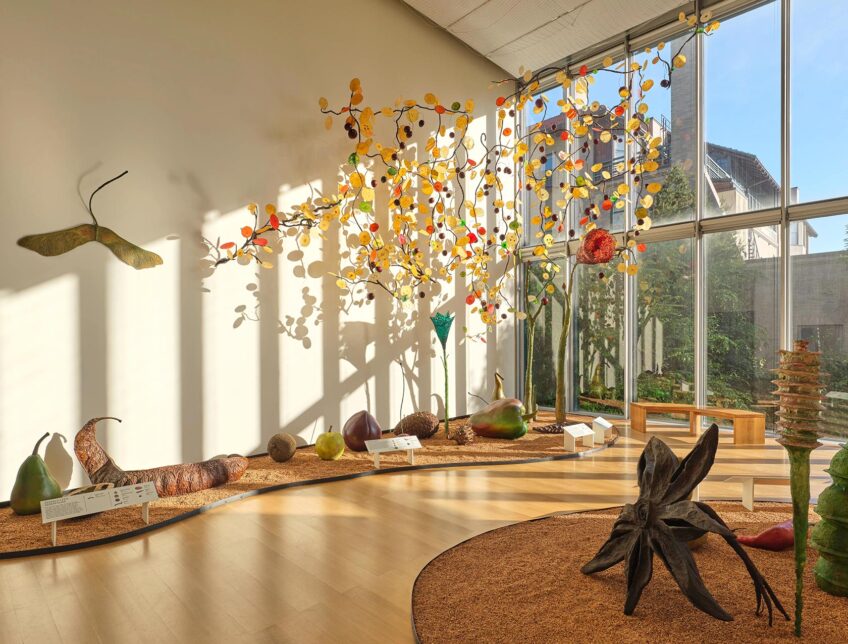In their eyes
Arab women photographers lift the shroud of the Muslim world


“Untitled XIII,” 2002 pigment print by Rula Halawani.
Young newlyweds gaze at the viewer from their beribboned wreck of a car, which stands alone in a battlefield. Iranian Gohar Dashti’s droll, staged photograph of life in a time of war is one of the many memorable works in a new exhibit at the Museum of Fine Arts, Boston, She Who Tells a Story: Women Photographers from Iran and the Arab World.
On view through January 2014 and curated by Kristen Gresh, who also created the show’s handsome catalog, the exhibition presents 100 works by 12 contemporary Arab and Iranian women photographers.
Countering clichéd Western views of women in Arabian cultures as submissive, shrouded and oppressed, these artists tell their own stories. Their works are art, but not for its own sake. Instead, the images are potent distillations of human experience, urgent as well as spectacular.
Drawing its title from the name of an artists’ collective, rawiya, an Arabian word that means “she who tells a story,” Gresh organizes the works into three groups: Deconstructing Orientalism, Constructing Identities, and New Documentary. The images explore such themes as gender power, the toll of war, gaps between the old and new and the struggle to carry on ordinary life in a war zone.
While all 12 artists were born in the Middle East, some currently live in the Europe or the United States. Only two are in their 50s and both of those live in New York: Shirin Neshat and Lalla Essaydi.
Inspired by a visit to Iran after the 1979 Revolution turned her formerly secular native country into a theocracy, Neshat’s pioneering work asserts the power of Iranian women through traditional Farsi imagery.
A still from her 1998 video installation “Turbulent,” which won the Gold Lion at the 1999 Venice Biennale, shows a female singer holding a microphone, her face covered with the words of young Iranian women handwritten in delicate Persian script.
Under Islamic rule, female singers cannot record or perform in public. But in Neshat’s film, male and female singers are equals. Appearing on opposite screens, the two seem to face each other. He performs first, before a male audience, singing verses by 13th century Sufi poet Rumi. She sings alone, in an empty hall. As his veiled female counterpart chants Islamic verses in wild, incantatory cries, the man’s face becomes a study in awe.
Morocco native Essaydi also takes up the traditionally male tool of Islamic calligraphy, applying it directly to her models and their clothing. Her 2012 tryptich “Bullets Revisited #3” is both alluring and ironic, enfolding a supine woman in a shimmering backdrop composed of metal bullet casings.

“Bullets Revisited #3,” three chromogenic prints on aluminum by Lalla Essaydi.
In her 2010 series “Listen,” Newsha Tavakolian of Tehran portrays six Iranian singers who, as women, are denied recordings and audiences. She creates for each an imaginary CD cover — one emerges from the sea like an Arabian Venus, a poignant image of freedom. In soundless video clips, she shows each woman singing.
Slit-eyed black niqabs gradually engulf a mother, daughter and doll over the course of nine photos in a 2010 series by Boushra Almutawakel, who lives in both Paris and Sana’a, Yemen. At first the artist shows herself, her child and the doll in sunny headscarves. The ninth photo is simply a black shroud.
In her 1996 installation, Iraq-born Londoner Jananne Al-Ani treats the veil as a fact rather than a symbol of oppression. On opposite walls, two large photographs show Al-Ani and four female relatives seated in a row. Cloaked in gradual stages of concealment, they stare at the viewer.
Shadi Ghadirian of Tehran juxtaposes images of old and new in a 1998 group of gelatin silver prints. In warm, vintage tones, the photographs portray young women in 19th century European-style studio backdrops. While dressed in traditional clothing, they listen to a boom box, hold a Pepsi and read a banned newspaper. Her 2008 series “Nil, Nil” is a set of painterly color prints that display bullets and grenades in fruit bowls, handbags and bedding.
Nermine Hammam, who lives in Cairo and London, takes the art of unexpected juxtapositions even further. She photographed young soldiers on duty in Tahrir Square during the January 2011 uprising. In her prints, she places their photos in candy-colored settings — bucolic alpine scenes and flowery verandas. With poignant humor, her incongruous images reflect the strangeness of violence and war.
Street photography by Tanya Habjouqa of East Jerusalem portrays scenes of defiantly ordinary joy in Gaza, a seaside enclave of Palestine isolated and attacked by its neighbors Egypt and Israel. Giddy girls, their hijabs flapping in the wind, enjoy a boat ride. In a photo of a family relaxing at the beach, the baby looks at the photographer.
In Egyptian Rana El Nemr’s 2003 series “The Metro,” the streamlined geometry of trains frames the women and their traditional garb. Human subject and setting also have equal weight in the 2009-2012 series “A Girl and Her Room,” portraits of young women in the Middle East by Beirut native Rania Matar, who lives in Brookline.

“Untitled #2,” a pigment print photograph by Gohar Dashti is on display at the Museum of Fine Arts, Boston, as part of the exhibit She Who Tells a Story: Women Photographers from Iran and the Arab World.
The wonder of this show is the way it brings together artists who are inventively using the medium of photography to make unseen or overlooked experiences visible — including scenes of joy, growth and change, as well as oppression and loss.
Rula Halawani in East Jerusalem blows up her negatives of the 2002 Israeli incursion into the West Bank to create ghostly images of human suffering and charred ruins.
Jananne Al-Ani traces the human imprints on landscapes of the Middle East, using aerial photography to capture contours of roads and buildings that emerge as shadows in the late-day sun. As the plane engine drones, her video shows the curves of long-abandoned desert roads, as ornate as Farsi script.






